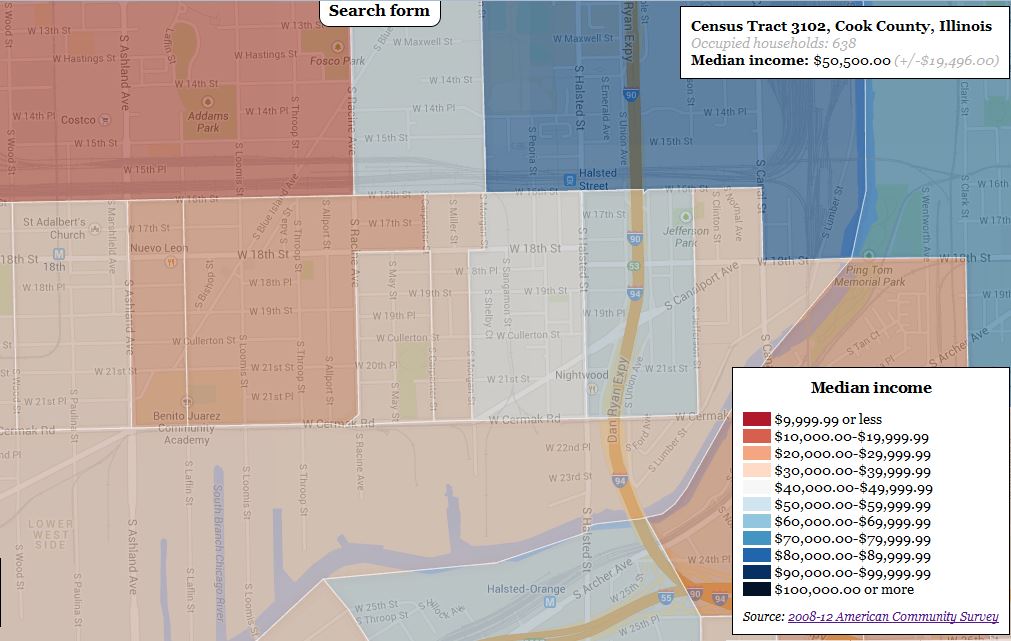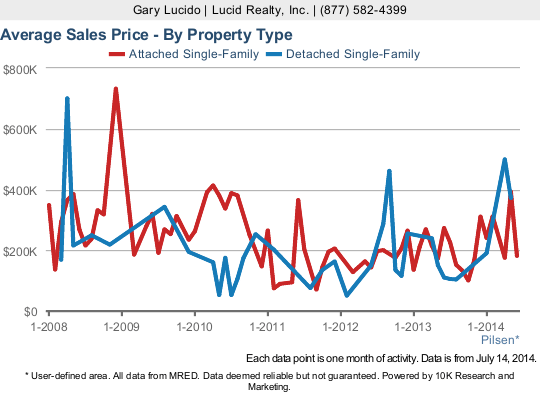The last time I wrote about how Chicago’s Pilsen’s neighborhood is changing I focused on a lot of softer indicators of change. (That post, BTW, also generated a surprising amount of vitriol in the comments section from a few people who apparently don’t like things changing and decided to direct their anger at me.) At the time I promised a follow up post that would focus more on what the hard data tells us about how Pilsen is changing. Here it is.
The only thing is that I originally expected to find no data pointing to change but in fact some of the data does indicate a real change is underway. One of the reasons I was so skeptical about Pilsen is that, as I mentioned last time, it has been threatening to change for decades, without much evidence of change. For instance, someone sent me this excerpt from a 1977 publication about Pilsen which shows that there was supposedly gentrification going on back then. But when I moved into University Village around 2002 I didn’t see much evidence of gentrification at all.
Median Income In Pilsen
Like it or not median income is a primary indicator of what’s going on with real estate in a neighborhood. Home prices can not go up (and face it, that’s what home owners are focused on) without incomes going up – whether they go up by existing residents earning more money or more affluent residents moving in.
So I look at this sort of data all the time and I SWEAR the last time I looked at Pilsen (within the last 6 months) it did not look like this. The heat map below shows the median household income by census tract. The last time I looked at this map Pilsen was pretty much all some shade of pink, meaning the median annual household income was $40,000 for the entire area, with some areas at $30,000.
Now I look at it and it has two blue rectangles between Morgan and Jefferson where the median income is $50,000. You’ll notice that the median income drops to $30,000 between Racine and Ashland but other than that one area it’s $40,000 west of Morgan. So the median income is indeed rising.
You can click on that heat map for a larger image.
Crime In Pilsen
One of the bigger issues facing the residents of Pilsen is that crime is higher than many potential and current residents are comfortable with. In the crime map below, which shows assaults and batteries for a 12 month period ending one year ago (yeah I need to update it someday), you can see the difference between Pilsen and University Village/ University Commons just north of the tracks and east of Racine. Usually crime drops as a real estate market rises so it looks like Pilsen has quite a ways to go before it’s as attractive as it’s northerly neighbors.
That’s an interactive map, BTW.
Pilsen’s Real Estate Market
Probably the best indicator of how hot the real estate market is in a neighborhood is the median or average price trend of homes sold there. As I’ve explained on numerous occasions this is not equivalent to knowing what’s happening to prices because it is largely influenced by the mix of housing sold. So, really, it incorporates both price changes and mix changes. But that’s still useful because potential and current homeowners want to see that number rising regardless of what’s driving it.
Herewith is the data for Pilsen (I decided to go with average prices) and it doesn’t paint a very pretty picture of a hot real estate market. The chart below shows that the properties being sold are selling for fairly low prices and they really aren’t rising all that much.
The bottom line in all this data is that if Pilsen is indeed on the way up it’s in the very earliest stages of a turnaround. It has a long way to go. So people looking to jump in on a rising real estate market better be really patient because they will definitely be pioneers.
Next Time
I do want to do one more post on Pilsen, focusing on the state of housing there. I’ve had some interesting experiences with the housing stock there.
#Pilsen
If you want to keep up to date on the Chicago real estate market, get an insider’s view of the seamy underbelly of the real estate industry, or you just think I’m the next Kurt Vonnegut you can Subscribe to Getting Real by Email. Please be sure to verify your email address when you receive the verification notice.

